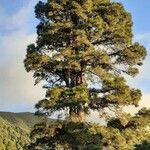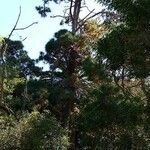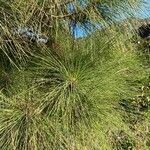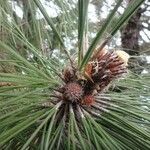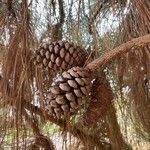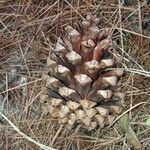Tree to 30 m tall. Bark thick, pale red-brown, partly shedding in rounded scales. Resting buds ovoid, 15-40 mm long, pale brown, non-resinous, with deeply fringed, reflexed, deciduous scales. Leaves in bundles of 3, 15-30 cm long, finely toothed, with 2 septal and external resin canals and 2-4 stomatal lines on each surface, glossy, slightly glaucous when young, becoming pale green; basal sheath 15-20 mm long. Female cones narrowly conical to cylindrical, symmetrical, 10-22 cm long, pedunculate, pendulous, often persisting for 1-several years after maturity; scales oblong, with a prominent but not spinose apex. Seeds with a well-developed wing.
Up to 30 m; bark becoming thick, slightly fissured, reddish-brown. Twigs glabrous, yellow. Buds ovoid, not resinous; scales broadly white-fringed. Leaves 200-300 x 1 mm, in threes, slender, acute, densely crowded; resin-canals submarginal. Cone 10-20 x 4-7 cm, ovoid-conic, shortly stalked, deflexed; apophysis depressed-pyramidal; umbo not mucronate. Seed c. 12 mm; wing c. 20 mm.
A large tree. It grows 40-60 m high and spreads 8 m wide. The trunk is straight and solid. The crown is dense and oval. The bark is reddish brown. The needles are 15-30 cm long. They are in threes. They tend to droop. The cones are shiny and brown. The female cones are symmetrical and lack spiny tips. The seeds are winged.
